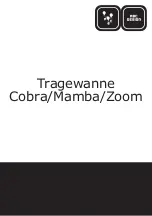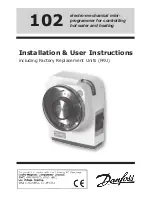
11
10.3. Assembly with outward opening window
A. Mark the centre line of the frame in pencil on both moveable and fixed parts (Fig. 1).
When more than one actuator is installed on the same window, mark as indicated in §
10.2 above.
B. Place the motor support bracket along the edge of the fixed part of the frame in line
with the centre line marked out previously and mark the positions for the four holes
for the fixing screws (Fig. 2).
C. Drill the window frame with a suitable bit and mount the motor support bracket, making
sure that the screws are firmly tightened (Fig. 3 and Fig. 3bis).
D. Line up the front bracket along the centre line on the moveable part of the frame and
mark out the holes required for the screws (Fig. 4).
E.
Drill the holes and screw in the front bracket, making sure that all screws are fitted
tightly
(Fig.5 and Fig. 5bis).
F. Take the clamp screws and connect them to the motor support bracket. Leave them
slack by at least two turns.
G. Insert the dove-tailed section of the actuator into the clamp screws. Make sure the
shaped part of the base fits neatly into the slot to ensure the actuator runs smoothly
along its axis
(Fig. 6).
H.
Then position the actuator so that the hole provided in the rack engages the front
attachment bracket.
Insert the M6x25 screw into the bracket and into the eyebolt and
tighten the self-locking bolt with two 10 spanners.
I. Manually move the actuator along its axis to close the frame and make it weather
tight. Tighten the clamp screws previously only placed and set the actuator in line
with the frame. Suggested tightening torque is 4-5 Nm.
J.
Plug the actuator in and carry out a test to check opening and closure of the frame.
Make sure the frame closes fully and is weather tight.
K.
The limit switch for the actuator is automatic on re-entry. The equipment will exert a
pressure to guarantee even the largest of frames is completely weather tight.
10.4. Installation on domed rooflights, dormers or industrial skylights
To install the actuator on these types of windows, follow the instructions for
“Installation on
awning windows”
given in § 10.3 above.
10.5. Assembly with opening inwards
A.
Mark the centre line of the frame in pencil on both moveable and fixed parts
(Fig. 1).
When more than one actuator is installed on the same window, mark as indicated in § 10.2
above.
B.
Place the motor support bracket along the edge of the moveable part of the frame in
line with the centre line marked out previously and mark the positions for the four
holes for the fixing screws
(Fig. 2).
C.
Drill holes into the frame and screw in the motor support bracket, making sure that
all screws are fitted tightly
(Fig. 3 and Fig. 3bis).
12
D.
Line up the front bracket along the centre line on the fixed part of the frame and
mark out the holes required for the screws
(Fig. 4).
E.
Drill the holes and screw in the front bracket, making sure that all screws are fitted
tightly
(Fig. 5 and Fig. 5bis).
F.
Take the clamp screws and connect them to the motor support bracket. Leave them
slack by at least two turns.
G. Insert the dove-tailed section of the actuator into the clamp screws. Make sure the
shaped part of the base fits neatly into the slot to ensure the actuator runs smoothly
along its axis
(Fig. 6).
H. Then position the actuator so that the hole in the rack is aligned with that in the front
attachment bracket. Insert the M6x25 bolt into the bracket and the hole in the rack; then
fix the self-locking nut with two 10 mm hex keys.
I. Manually move the actuator along its axis to close the frame and make it weather
tight. Tighten the clamp screws previously only placed and set the actuator in line
with the frame. Suggested tightening torque is 4-5 Nm.
J. Perform a complete opening and closing test on the window. When the closing
operation is completed, ensure that the window is properly closed by checking the
compression of the seals.
K. The stroke-end of the actuator during return is automatic. The device exerts traction to
ensure perfect compression of the seals.
10.6. Installing the actuator and rod (or transmission) with a connection bar
Skyro 650 actuators can be connected in tandem using a rod without a motor, by
means of a mechanical connection bar. The movement of one actuator is mechanically
linked to the rod in order to transmit motion in a uniform manner and at the same
speed.
Two or more actuators can be installed on the window frame, with one or more Syncro³
version motors, depending on the force requirements.
Assemble as follows:
A. Mark the assembly distance between centres for the two actuators out onto the
frame in accordance with the measurements in the above table.
B. Place the support brackets of the actuator into position, mark
out the holes for drilling, drill the frame and mount the brackets
(see “Assembly for outward opening windows” for details).
C. Place the front brackets into position, mark out the holes for
drilling, drill the frame and mount the front brackets (see
“Assembly for outward opening windows” for details).
D.
Mount the actuators
E. Mount the connection bar as follows:
Insert the connection bar first into one of the actuators, and then into the second
actuator. Make sure the bar protrudes at least 2 mm from each actuator
(Fig. 7).
Fig. 7






























